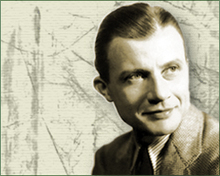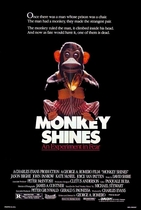Our editor-in-chief Nate Yapp is proud to have contributed to the new book Hidden Horror: A Celebration of 101 Underrated and Overlooked Fright Flicks, edited by Aaron Christensen. Another contributors include Anthony Timpone, B.J. Colangelo, Dave Alexander, Classic-Horror.com's own Robert C. Ring and John W. Bowen. Pick up a copy today from Amazon.com!
Dwight Frye
Horror film actors are probably the most typecast actors ever, whether it brings them great success (Lon Chaney Sr., Boris Karloff, etc) or it brings them great failure (Bela Lugosi, Lon Chaney Jr., etc) in their lifetimes. But no matter if they're top billed or uncredited in a minor cameo, they always seem to put forth 120% into their performances. That was very much the case for Dwight Frye, one of the most typecast actors in all of horror film history. He gained his claim to fame in the early talkies as Renfield, the crazed, insect eating madman in Tod Browning's Dracula. After this success for Universal, Frye would be catapulted into playing a whole bunch of lunatics, half wits, spies and red herrings, all which led him into a deep frustration. But with all of these road stops in his acting career, Dwight managed to play every role of his with such intensity, passion and conviction, and has made a indelible mark onto the minds of horror film fans that will stay with them forever (one that isn't from the bite of a vampire).
Dwight Iliff Fry (adding the E later on because it looked fancy on paper) was born on February 22nd, 1899 in Salina, Kansas to Charles and Ella Fry. An only child, Dwight and his parents soon moved to Denver, Colorado. He was drawn to the stage at a very young age, performing in several different stock companies. A while after attending college, he was invited to become a part of The Denham Theatre in Denver, headed by O.D. Woodward's stock company. Dwight gladly accepted it, and after that, his success in theater would boom rapidly. His first documented performance was the minor role of Richard Daunton in The Man from Mexico on June 16th, 1918. He played several bigger parts for Woodward, like Hobson in Captain Rackett and Gerald Homes in A Bachelor's Romance, before moving east to many theaters like The Colonial Theatre in Pittsfield, Massachusetts, and eventually finding his way to Broadway.
Dwight made his debut in New York City on September 5th, 1922, as a comic burglar in The Plot Thickens, which premiered at The Booth Theatre on 45th Street (unfortunately, that was the same night when two young Broadway actresses both committed suicide). Dwight enjoyed a successful career on Broadway, with such roles like The Son in Six Characters in Search of an Author at The Beachwood Theatre, Alfons the Spider in Mima at The Belasco, and Max Duvelleroy in The Love Habit at the Bijou Theatre. During this time, he managed to meet his future wife, Laura May Bullivant, who he would later marry in 1928. By the late 1920's, Dwight managed to become one of the most versatile actors on Broadway, ranging from dramas and romances to comedies, period pieces and westerns. He and Laura then made the move to Hollywood in 1929 to try his luck at the movies, a move that would change the rest of his life forever.
Universal Studios was rising up to become one of the major motion picture studios. Carl Laemmle, who founded the company in 1912, handed the reins over to his son, Carl Laemmle Jr. Junior decided to take Universal into a new direction that few studios were reluctant to do - the gothic horror film. Junior was always a fan of frightening movies and everything morbid. It was here that he made the choice to produce a film adaptation of Dracula, first written by Bram Stoker in 1897, and then made into a stage play in 1924 by Irish playwright Hamilton Deane, and later into an American Broadway version in 1927, written by John L. Balderston. Senior objected to producing such a frightening picture. But Universal made a great deal of money on such silent films as The Hunchback of Notre Dame and The Phantom of the Opera, so Junior went through with producing Universal's first talkie chiller. One of the problems they had was finding the right man to play Renfield, Dracula's familiar whose domain is at the Seward Sanitarium due to his thirst for blood (animal blood that is). Bernard Jukes, who originated the tortured lunatic in both London and on Broadway, was lobbying for the part with extreme intensity. But, for unknown reasons, Tod Browning, who directed many of Lon Chaney's films (The Unholy Three, The Unknown, London After Midnight) saw something in Mr. Frye that captivated and fascinated him. With that, I believe, Dwight got the part with which he would forever be known for and typecast by.
Dracula started production on September 29th, 1930 and wrapped up on November 15th, 1930. From Dwight's experience on the set, it was certainly an interesting one. Bela Lugosi would be parading around in his cape, swirling it in fury, exclaiming, "I am Dracula!" into a giant soundstage mirror. Tod Browning was very much uncommunicative; not really there. Karl Freud would either be directing some of the day's scenes or yelling at Browning to get up and start directing. And former Broadway actress Helen Chandler laughing nervously at all of this, sitting alongside David Manners; nervous mainly because "she was under the real-life spell of alcohol" But Dwight enjoyed his time working on this marvelous cinematic adventure, being witness to Lugosi's awe inspiring dedication and Chandler's admirable nature, considering where she was at that time.
Dracula finally premiered nationwide on February 14th, 1931 (Valentine's Day no less!). Men were shocked into terror, women screamed in pure horror, not only at Lugosi's phenomenal performance, but for Dwight's as well. As one reviewer said, "his maniacal laugh pounces on the brain". He not only played a madman, but he completely immersed himself into lunacy; it was that astounding. As said before, the role of Renfield catapulted him into mainstream horror cinema. But just two months prior, Dwight was already overfilled with joy due to the birth of his and Laura's only son, Dwight David Frye Jr., on December 26th, 1930. Things seemed to be looking good for The Man with the Thousand-Watt Stare, for now.
Later that year, along with playing the psychopathic gangster Wilbur Cook in The Maltese Falcon, Dwight would create yet another signature horror role, one that would eventually become a cliché of the genre - the hunchback Fritz in Frankenstein. Under Robert Florey's direction at the time, Fritz was to have no dialogue whatsoever. But after Florey got kicked off the project for unknown reasons, another person soon stepped in, a talented British stage director named James Whale. From there, Frankenstein was underway, which began production on August 24th, 1931 for a 30 day planned shooting schedule. Dwight would be scuttling across the graveyard set and in the laboratory, like one of the spiders he desired to consume in Dracula. According to Mae Clarke herself, Dwight in full character and makeup was "sometimes more frightening than the Monster". Frankenstein finally wrapped on October 3rd, 1931, premiering on November 20th, 1931 nationwide. Like Dracula earlier that year, people ran out of the theatre and into the streets, screaming, appalled at the onscreen horror that was going on before them. Unearthing dead bodies, cutting a man down from the gallows, and the Frankenstein monster being sadistically bullied to the greatest degree by Fritz, with both a whip and torch in hand. Dwight was most proud that he originated two totally different bizarre characters in the same year and that they were popular with audiences still. After making a short cameo in James Whale's The Invisible Man in 1933 as a news reporter, he would yet again go on to play another lunatic - Herman Gleib in The Vampire Bat, a simple minded village idiot who loved and domesticated bats.
1935 seemed to be decent year for Dwight's career, though not as substantially better as 1931. He would go on to play against type as Dr. Thomas in The Crime of Dr. Crespi, the good doctor battling wits with Erich Von Stronheim as the title villainous doctor. Along with this, he worked with James Whale for the last time on Bride of Frankenstein, playing the minor part of Karl, Dr. Pretorius's assistant. Originally, this particular role was intended to be much bigger, with a subplot about Karl murdering his dear aunt and uncle and blaming it on Karloff's monster. Bride, beginning production on January 2nd, 1935 and wrapping up on March 7th, 1935, premiered at Hollywood's Pantages Theatre on April 20th, 1935. Without the added subplot though, Karl managed to be one of Dwight's best remembered character roles in film.
Unfortunately, 1931 and 1935 would be the only high points for Dwight's career. It would be plagued with nothing but short roles, throw away parts and cameos from now on. Most of the time, he was not even credited, and his scenes from certain films would be cut out altogether! His part in Son of Frankenstein was cut after Universal Studios decided to switch from Technicolor to standard black and white film, as Jack Pierce couldn't get Karloff's makeup to look right in color. Dwight would return to the theater for possibly the final time, playing Renfield in a revival of Dracula in 1941 along with Fredrick Pymm as the titular vampire. He would appear in small roles as villagers in the next two Frankenstein films, Ghost of Frankenstein and Frankenstein Meets the Wolf Man. His final horror film appearance was in Dead Men Walk, playing Zolarr, a mixture of Renfield and Fritz who served his vampire master Elwyn Clayton, played by George Zucco. He would eventually be offered a role that would never come to light and could've possibly gotten him into the mainstream eye as the true talent that he was - Secretary of War Newton D. Baker in the 20th Century-Fox biopic, Wilson. On November 7th, 1943, after seeing a double feature of A Lady Takes a Chance and Sherlock Holmes Faces Death with his son, Dwight and him boarded a Los Angeles bus, where he collapsed, being rushed to the nearest hospital. Dwight Frye died that night at 11:15 p.m. due to a coronary thrombosis. He was buried at the Forest Lawn Cemetery in Glendale, California, where he still remains to this day.
Luckily, his legacy as an actor never went unnoticed. Almost immediately, he received his first fan letter in 1945, just two years after his death. Many movie reviewers and historians for magazines like Famous Monsters wrote glowing tributes to The Man with the Thousand-Watt Stare. Shock rocker Alice Cooper was so inspired by Frye's performance in Dracula that he recorded a 7 minute long song entitled 'The Ballad of Dwight Fry(e)'. Today, Dwight is known and regarded as one of the great classic horror film actors, alongside Lugosi, Karloff and more. Even though he never got the praise he deserved during his life time, he certainly has gotten so much in the last 70 so years. With all of the parts he was given, horror or not, stage or film, Dwight presented himself to others the best way any actor can - with undying dedication and love for his craft! Truly, Dwight Frye has gotten the last laugh on everyone!
Source: Mank, Gregory W, James T. Coughlin, and Dwight D. Frye. Dwight Frye's Last Laugh: An Authorized Biography. Baltimore, Md: Midnight Marquee Press, 1997. Print.








